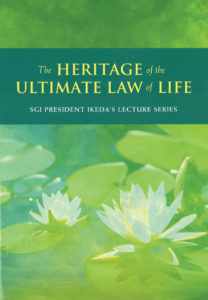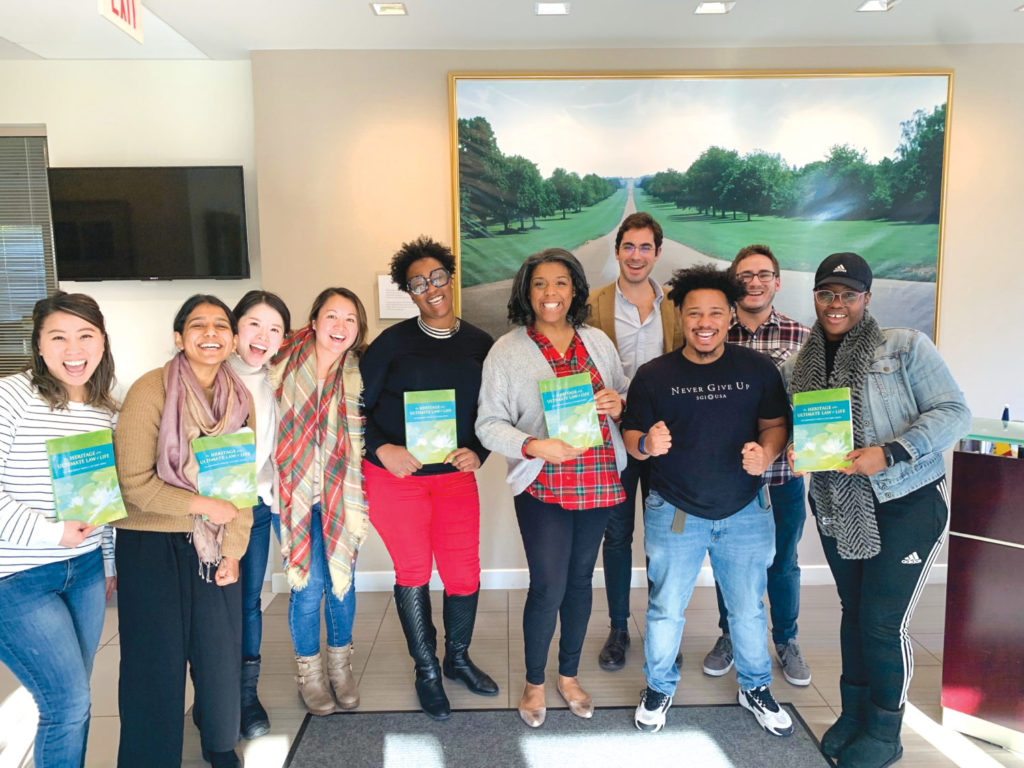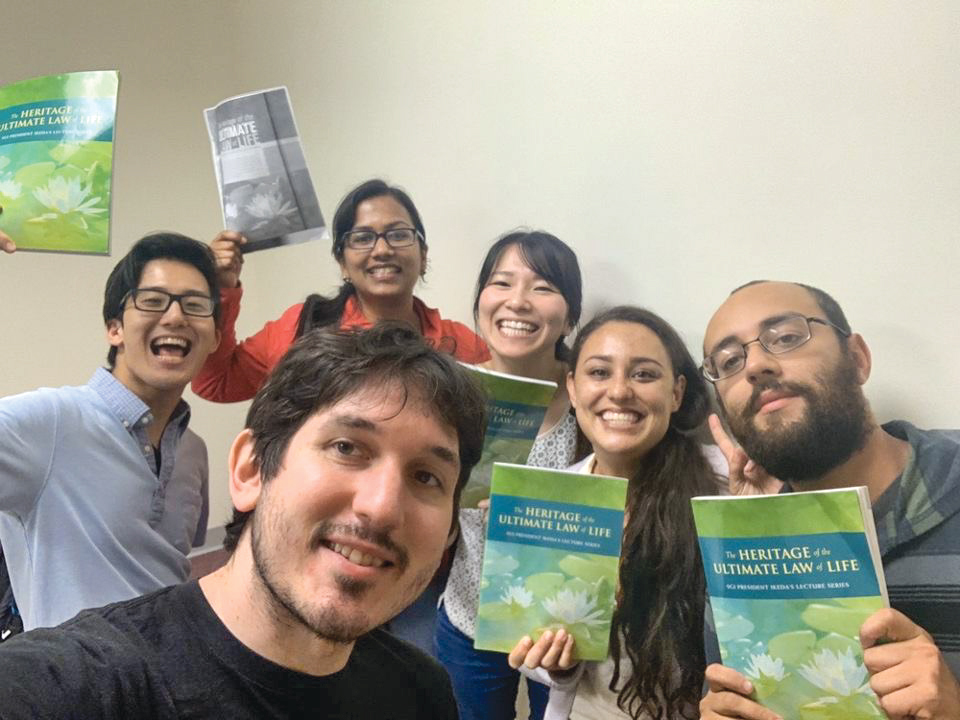The Ikeda Wisdom Academy is an SGI-USA youth division movement to engage youth leaders in advanced study. This month, academy members will study chapter 11 of The Heritage of the Ultimate Law of Life: SGI President Ikeda’s Lecture Series.
While the Ikeda Wisdom Academy is a youth leaders study program, all SGI-USA members are invited to utilize this section of Living Buddhism as a guide for their personal study of “The Heritage of the Ultimate Law of Life.”
– – – – – – – – – – – – – – – – – – – – – – – – – – – –
Syllabus – May 2020
The Heritage of the Ultimate Law of Life: SGI President Ikeda’s Lecture Series, Chapter 11
– – – – – – – – – – – – – – – – – – – – – – – – – – – –

Chapter 11
Bodhisattva Superior Practices—Pioneering the Way for Human Victory by Unlocking the Highest Potential of All People

Nam-myoho-renge-kyo is the ultimate Law of life and death transferred from Shakyamuni and Many Treasures to Bodhisattva Superior Practices. Because Nichiren Daishonin opened the way for all humanity to inherit this Law in the Latter Day, he serves the function of Bodhisattva Superior Practices. Thus, the heritage of the ultimate law of life and death flows in the lives of those who practice with the same commitment as him.
How admirable that you have asked about the transmission of the ultimate Law of life and death! I have never heard of anyone who has asked such a question. I have answered in complete detail in this letter, so please take it deeply to heart. The important point is to carry out your practice confident that Nam-myoho-renge-kyo alone is the heritage that was transferred from Shakyamuni and Many Treasures to Bodhisattva Superior Practices.
The function of fire is to burn and give light. The function of water is to wash away filth. The winds blow away dust and breathe life into plants, animals, and human beings. The earth produces the grasses and trees, and heaven provides nourishing moisture. The five characters of Myoho-renge-kyo are also like that. They are the cluster of blessings brought by the Bodhisattvas of the Earth, disciples of the Buddha in his true identity. The Lotus Sutra says that Bodhisattva Superior Practices will appear now, in the Latter Day of the Law, to propagate this teaching, but has this happened? Whether or not Bodhisattva Superior Practices has appeared in this world, Nichiren has already made a start in propagating this teaching. (The Writings of Nichiren Daishonin, vol. 1, pp. 217–18)
Inner joy and vitality are indispensable to realizing happiness for ourselves and others and to construct an alliance of people dedicated to the cause of good. We can only deeply inspire others through our own lives, and we can only spur them to embark on inner change through our actions and conduct as people undertaking this same challenge.
How can we break through the closed, hardened shell of a person’s life in the Latter Day of the Law, which as a result of karma and self-absorption often resembles an inhospitable frozen wasteland? And how can we activate people’s Buddha nature and awaken them on a fundamental level so that they can transform their lives? This is the endless challenge of our Buddhist practice. And that is why we ourselves must be active and engaged Buddhists who continue to work on our own inner transformation.

Washington, D.C.
In the Lotus Sutra, the Bodhisattvas of the Earth—the countless bodhisattvas who emerge dynamically from the earth when the ground trembles and splits open—come forward to take on this mission. And Bodhisattva Superior Practices is their leader. (The Heritage of the Ultimate Law of Life: SGI President Ikeda’s Lecture Series, pp. 111–12)
The Significance of the Transmission From Shakyamuni and Many Treasures to Bodhisattva Superior Practices
Nichiren states: “The Lotus Sutra says that Bodhisattva Superior Practices will appear now, in the Latter Day of the Law, to propagate this teaching, but has this happened? Whether or not Bodhisattva Superior Practices has appeared in this world, Nichiren has already made a start in propagating this teaching” (WND-1, 218).
Here, Nichiren is effectively affirming that he himself is Bodhisattva Superior Practices, who vowed to appear in the Latter Day of the Law. Therefore, the heritage of the ultimate Law of life and death flows in the lives of those who practice as Nichiren teaches and with the same commitment as he has.
Nichiren concludes in this writing that we should practice Nam-myoho-renge-kyo as the Law that was entrusted to Superior Practices by Shakyamuni and Many Treasures. But a deeper interpretation can also be given to his emphasis of this point—namely, that this entrustment signifies a major transition from the Buddha of true effect to the Buddha of true cause and, by extension, from the Buddhism of true effect to the Buddhism of true cause.
In short, it is not simply a transfer of the Law from Buddha to bodhisattva, but rather a radical change in the very framework of the Buddhist teachings and in the person who serves as the teacher, or—to use Buddhist terminology—“the lord of teachings.” When considered in this light, the profound significance of Nam-myoho-renge-kyo, as the Law entrusted to Superior Practices, becomes clear. (Lecture Series, 112–13)
From the Buddha of True Effect to the Buddha of True Cause
Let us look briefly at the meaning of true cause and true effect. In the “Life Span” chapter of the Lotus Sutra, Shakyamuni reveals that he has “in fact attained Buddhahood” in the remote past. True cause refers to the practice he undertook at that time to realize that goal, while true effect refers to the enlightened state of Buddhahood he achieved as a result. That is the literal meaning of these concepts.
■ ■ ■
The Buddha and the teachings of true effect expound a supreme state of existence that, in a sense, transcends what is attainable by human beings. Because this is beyond ordinary comprehension, the Buddha and the teachings of true effect ultimately have no meaning for ordinary people except as metaphors.
Referring to the essence of the Buddha and the teachings of true effect, Nichiren Daishonin states in “The Gift of Rice” that they teach that the clarity of the Buddha’s mind is like the moon and the purity of the Buddha’s mind is like a flower (see WND-1, 1126). With this simple illustration, he indicates that they are merely figurative.
In contrast, the designation of “true cause” refers to the Buddha and the teachings that reveal the supreme and fundamental cause for attaining enlightenment. Since the cause lies on the side of the practitioners, the teachings of true cause are those that expound the ultimate causality for attaining Buddhahood in a way that is relevant to the lives of ordinary people.
Bodhisattva Superior Practices, having re-ceived the heritage of the Law from Shakyamuni and Many Treasures, is a bodhisattva who appears in this actual saha world as an ordinary human being. In order to realize the Lotus Sutra’s ideal of universal enlightenment, it is necessary for him to not only practice the ultimate Law of cause and effect for attaining Buddhahood but also to embody it in his own life as a human being, and to then convey it to others in the Latter Day.
The Buddhism of true cause is predicated on ordinary people embodying the ultimate Law of cause and effect for attaining Buddhahood in their lives, just as they are. Both cause and effect reside within us. The Buddhism of true cause describes this as “the Mystic Law of the simultaneity of cause and effect.”
■ ■ ■
The crux of the Lotus Sutra lies in its explanation of the entrustment, or transmission, of the heritage of the Law from Shakyamuni and Many Treasures to Bodhisattva Superior Practices. The very fact that the Lotus Sutra depicts this transfer of the Law signals that a fundamental shift in emphasis in the teaching from true effect to true cause will be essential at a future time if the Lotus Sutra ideal and Buddha vow of universal enlightenment is to be realized. (Lecture Series, 113–16)
The Essence of the Buddhism of True Cause—A Struggle Against Devilish Functions
Throughout his life, Nichiren held fast to his vow to enable all people to attain enlightenment and to realize a society where all can live in peace and happiness. These are the aspirations of the Lotus Sutra.
He infused his faith in the Lotus Sutra into the practice of chanting Nam-myoho-renge-kyo, which he taught to others without sparing his voice. And he was persecuted by corrupt priests and secular authorities who could not understand the true meaning of the Lotus Sutra. Yet while encountering momentous obstacles like those described in the Lotus Sutra, he persevered unflaggingly in his struggle without begrudging his life, triumphing over all.
Through these struggles as a human being residing in the saha world, he solidly established in his life the merit of practice and the benefit of Buddhahood, and came to manifest the life state of the Buddha of perfect enlightenment, the embodi-ment of the Mystic Law of the simultaneity of cause and effect. I am referring to Nichiren casting off his transient status and revealing his true identity as the Buddha of the Latter Day of the Law at the time of the Tatsunokuchi Persecution (1271). …
Nichiren inscribed the Gohonzon, the object of devotion, by embodying in the form of a mandala the true cause and true effect that he manifested in his life. And he also established Nam-myoho-renge-kyo of the Three Great Secret Laws as the practical means by which all people could achieve genuine, lasting happiness, which is the fundamental aim of the Lotus Sutra.
Nichiren’s deep conviction as to his identity as Bodhisattva Superior Practices is evident from statements he makes in various writings. For example, in “The Teaching, Practice, and Proof,” he says: “Who among our contemporaries, what school of Buddhism, is actually propagating the object of devotion and the sanctuary of the essential teaching? Not a single person carried out this task during the 2,220 years and more following the Buddha’s passing. … Superior Practices, the leader of the Bodhisattvas of the Earth, has already made his advent in this world, so the great Law, the essence of the Lotus Sutra that was entrusted to him, will spread without fail” (WND-1, 482).
This passage vividly conveys Nichiren’s towering state of life. It is as if he is saying:
“I alone uphold the banner of the Mystic Law and have brought to life the spirit of the Lotus Sutra. No one can refute this fact. It is an unprecedented event in the history of Buddhism.” …
Nichiren is the Buddha of the Latter Day of the Law who established the Buddhism of the people, a teaching open to all. He proved the power of the Buddhist Law through his own lifelong efforts as a “bodhisattva-Buddha,” as an ordinary human being.
■ ■ ■
Victory can take many forms, but there is surely no greater victory than breaking through the darkness of innate ignorance, bringing forth the life state of Buddhahood and producing an infinite number of successors who can carry on the noble cause of kosen-rufu. In view of the scale of the victory he achieved, Nichiren is the fundamental teacher of the Latter Day of the Law. Most impor-tant, because he opened the path for all people to reveal their inherent Buddhahood by chanting Nam-myoho-renge-kyo and established a truly humanistic religious philosophy, we regard him as a teacher of humankind. (Lecture Series, 116–20)
The Great Path of a Humanistic Religion
The genuine practice of Buddhism from the times of Shakyamuni and Nichiren lives on in the practice of mentor and disciple in the Soka Gakkai. This practice comprises efforts based on a stand-alone spirit (the spirit to act based on a sense of full personal responsibility in the struggle for kosen-rufu).
By committing ourselves to the great vow for kosen-rufu, we can manifest our own inherently enlightened life state. And by taking action with an ungrudging spirit, we can free people from suffering and help them revitalize their lives. These awakened people in turn, through the power of dialogue, can inspire still others, giving them fresh courage and conviction. The stand-alone practice of the first three presidents—united by the bonds of mentor and disciple—is the starting point of the magnificent worldwide spread of our movement for human revolution, or inner transformation. (Lecture Series, 120)
You are reading {{ meterCount }} of {{ meterMax }} free premium articles

